Basic Principles of Sensation and Perception
5-1 What are sensation and perception? What do we mean by bottom-up processing and top-down processing?

 Sellers’ curious mix of “perfect vision” and face blindness illustrates the distinction between sensation and perception. When she looks at a friend, her sensation is normal: Her senses detect the same information yours would, and they transmit that information to her brain. And her perception—the processes by which her brain organizes and interprets the sensory input—is almost normal. Thus, she may recognize people from their hair, walk, voice, or peculiar build, just not from their face. Her experience is much like the struggle you or I would have trying to recognize a specific penguin.
Sellers’ curious mix of “perfect vision” and face blindness illustrates the distinction between sensation and perception. When she looks at a friend, her sensation is normal: Her senses detect the same information yours would, and they transmit that information to her brain. And her perception—the processes by which her brain organizes and interprets the sensory input—is almost normal. Thus, she may recognize people from their hair, walk, voice, or peculiar build, just not from their face. Her experience is much like the struggle you or I would have trying to recognize a specific penguin.
In our everyday experiences, sensation and perception blend into one process. In this chapter, we slow down that process to study its parts. In real life, our sensory and perceptual processes work together to help us decipher the world around us.
- Our bottom-up processing starts at the very basic level of sensory receptors (more on those below) and works up to higher levels of processing.
- Our top-down processing constructs perceptions from the sensory input by drawing on our experience and expectations.
As your brain absorbs the information in FIGURE 5.1, bottom-up processing enables your sensory systems to detect the lines, angles, and colors that form the flower and leaves. Using top-down processing, you interpret what your senses detect.
But how do you do it? How do you create meaning from the blizzard of sensory stimuli bombarding your body 24 hours a day? Meanwhile, in a silent, cushioned, inner world, your brain floats in utter darkness. By itself, it sees nothing. It hears nothing. It feels nothing. So, how does the world out there get in? To phrase the question scientifically: How do we construct our representations of the external world? How do a campfire’s flicker, crackle, and smoky scent activate neural (brain) connections? And how, from this living neurochemistry, do we create our conscious experience of the fire’s motion and temperature, its aroma and beauty? In search of answers to such questions, let’s look at some processes that cut across all our sensory systems. 
RETRIEVE + REMEMBER
Question 5.1
What is the rough distinction between sensation and perception?
Sensation is the bottom-up process by which the physical sensory system receives and represents stimuli. Perception is the top-down mental process of organizing and interpreting sensory input.
From Outer Energy to Inner Brain Activity
5-2 What three steps are basic to all our sensory systems?
Every second of every day, your sensory systems perform an amazing feat: They convert one form of energy into another. Vision processes light energy. Hearing processes sound waves. All your senses
- receive sensory stimulation, often using specialized receptor cells.
- transform that stimulation into neural impulses.
- deliver the neural information to your brain.
The process of converting one form of energy into another form that your brain can use is called transduction. Later in this chapter, we’ll focus on individual sensory systems. How do we see? Hear? Feel pain? Taste? Smell? Keep our balance? In each case, we’ll consider these three steps—receiving, transforming, and delivering the information to the brain.
First, though, let’s explore some strengths and weaknesses in our ability to detect and interpret stimuli in the vast sea of energy around us.
Thresholds
5-3 How do absolute thresholds and difference thresholds differ, and what is Weber’s law?
At this moment, you and I are being struck by X-rays and radio waves, ultraviolet and infrared light, and sound waves of very high and very low frequencies. To all of these we are blind and deaf. Other animals with differing needs detect a world that lies beyond our experience (Hughes, 1999). Migrating birds stay on course aided by an internal magnetic compass. Bats and dolphins locate prey using sonar, bouncing sounds off objects. Bees navigate on cloudy days by detecting aspects of sunlight we cannot see.
The shades on our senses are open just a crack, giving us only a tiny glimpse of the energy around us. But for our needs, this is enough.
Absolute Thresholds
To some kinds of stimuli we are amazingly sensitive. Standing atop a mountain on an utterly dark, clear night, most of us could see a candle flame atop another mountain 30 miles away. We could feel the wing of a bee falling on our cheek. We could smell a single drop of perfume in a three-room apartment (Galanter, 1962).
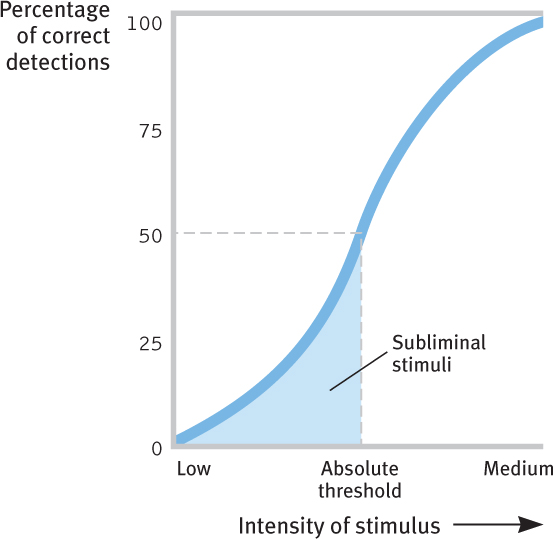
Our awareness of these faint stimuli illustrates our absolute thresholds—the minimum stimulation needed to detect a particular light, sound, pressure, taste, or odor 50 percent of the time. To test your absolute threshold for sounds, a hearing specialist would send tones, at varying levels, into each of your ears. The tester would then record whether or not you could hear each tone. The test results would show the point where half the time you could detect the sound and half the time you could not. That 50-50 point would define your absolute threshold for that sound.
Stimuli you cannot detect 50 percent of the time are subliminal—below your absolute threshold (FIGURE 5.2). Under certain conditions, you can be affected by stimuli so weak that you don’t notice them. An unnoticed image or word can briefly prime your response to a later question. Let’s see how this might work in a laboratory experiment. You’ve been asked to view slides of people and to give them either positive or negative ratings. But the trickster researchers also flash another image an instant before showing you each slide. Some of the flashed images will be emotionally positive (kittens, a romantic couple) and some will be negative (a werewolf, a dead body). You will consciously perceive these images only as flashes of light. Will they affect your ratings?
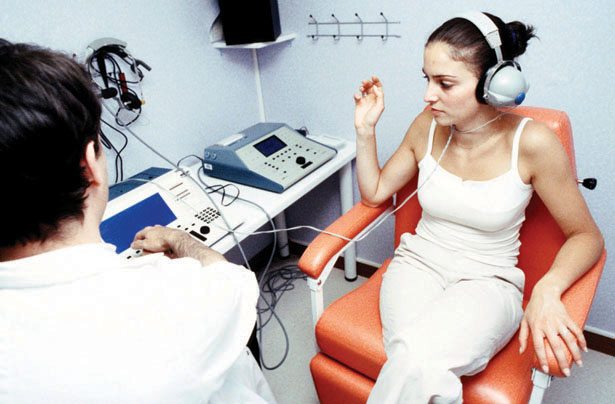
In this real experiment, people somehow looked nicer if their photo immediately followed unperceived kittens rather than an unperceived werewolf (Krosnick et al., 1992). This priming effect happened even though the viewer’s brain did not have enough time to consciously perceive the flashed images. As other experiments confirm, we may evaluate a stimulus even when we are not consciously aware of it (Ferguson & Zayas, 2009). Once again, we see the two-track mind at work: Much of our information processing occurs automatically, out of sight, off the radar screen of our conscious mind. Our conscious minds are upstairs executives who have delegated routine tasks to downstairs mental workers.
136
Can we be controlled by subliminal messages? For more on that question, see Thinking Critically About: Can Subliminal Messages Control Our Behavior?
Can Subliminal Messages Control Our Behavior?
THINKING CRITICALLY ABOUT
5-4 Can we be persuaded by subliminal stimuli?

Hoping to penetrate our unconscious, marketers offer audio and video programs to help us lose weight, stop smoking, or improve our memories. Soothing ocean sounds may mask messages we cannot consciously hear, such as “I am thin,” “Cigarette smoke tastes bad,” or “I do well on tests. I have total recall of information.” These subliminal messages, below our absolute threshold of awareness, supposedly change our lives. Such claims make two assumptions: (1) We can unconsciously sense subliminal stimuli. (2) Without our awareness, these stimuli have extraordinary persuasive powers. Can we? Do they?
As we have seen, subliminal sensation is a fact. Remember that an “absolute” threshold is merely the point at which we can detect a stimulus half the time. At or slightly below this threshold, we will still detect the stimulus some of the time.
But does this mean that claims of subliminal persuasion are also facts? Can subliminal recordings really help us make lasting behavioral changes, such as eating less or quitting smoking? Research results from 16 experiments on the influence of subliminal self-help recordings all reached one conclusion. The effect of subliminal stimuli is subtle and fleeting, with no powerful, enduring influence on behavior. Not one of the recordings helped more than a placebo (Greenwald et al., 1991, 1992). And placebos work only because we believe they will work.
Difference Thresholds

To function effectively, we need absolute thresholds low enough to allow us to detect important sights, sounds, textures, tastes, and smells. We also need to detect small differences among stimuli. A musician must detect tiny differences when tuning an instrument. Parents must detect the sound of their own child’s voice amid other children’s voices. Even after I had lived two years in Scotland, sheep baa’s all sounded alike to my ears. But not to those of ewes, as I observed. After shearing, they would streak directly to the baa of their lamb amid the chorus of other distressed lambs.

Many of life’s important decisions depend on our ability to detect such small differences. The minimum difference a person can detect between any two stimuli half the time is called a difference threshold (or a just noticeable difference [jnd]). That detectable difference increases with the size of the stimulus. Thus, if you add 1 ounce to a 10-ounce weight, you will detect the difference. If you add 1 ounce to a 100-ounce weight, you probably will not.
In the nineteenth century, Ernst Weber noted something so simple and so useful that we still refer to it as Weber's law. This law states that for an average person to perceive a difference, two stimuli must differ by a constant minimum percentage (not a constant amount). The exact percentage varies, depending on the stimulus. Two lights, for example, must differ in intensity by 8 percent. Two objects must differ in weight by 2 percent. And two tones must differ in frequency by only 0.3 percent (Teghtsoonian, 1971). 
137
RETRIEVE + REMEMBER
Question 5.2
Using sound as your example, show how these concepts differ: absolute thresholds, subliminal stimulation, and difference thresholds.
Absolute threshold is the minimum stimulation needed to detect a particular sound (such as an approaching bike on the sidewalk behind us) 50 percent of the time. Subliminal stimulation happens when, without our awareness, our sensory system processes the sound of the approaching bike (when it is below our absolute threshold). A difference threshold is the minimum difference needed to distinguish between two sounds (such as between the familiar hum of a friend’s bike and the unfamiliar sound of a different bike).
Sensory Adaptation
5-5 What is the function of sensory adaptation?
Entering your neighbors’ living room, you smell a musty odor. You wonder how they can stand it, but within minutes you no longer notice it. Sensory adaptation has come to your rescue. When we are constantly exposed to a stimulus that does not change, we become less aware of it because our nerve cells fire less frequently. (To experience sensory adaptation, move your watch up your wrist an inch. You will feel it—but only for a few moments.)
Why, then, if we stare at an object without flinching, does it not vanish from sight? Because, unnoticed by us, our eyes are always moving. This continual flitting from one spot to another ensures that stimulation on the eyes’ receptors is always changing.
What if we actually could stop our eyes from moving? Would sights seem to vanish, as odors do? To find out, psychologists have designed clever instruments that maintain a constant image on the eye’s inner surface. Imagine that we have fitted a volunteer, Mary, with one of these instruments—a miniature projector mounted on a contact lens (FIGURE 5.3a). When Mary’s eye moves, the image from the projector moves as well. So everywhere that Mary looks, the scene is sure to go.
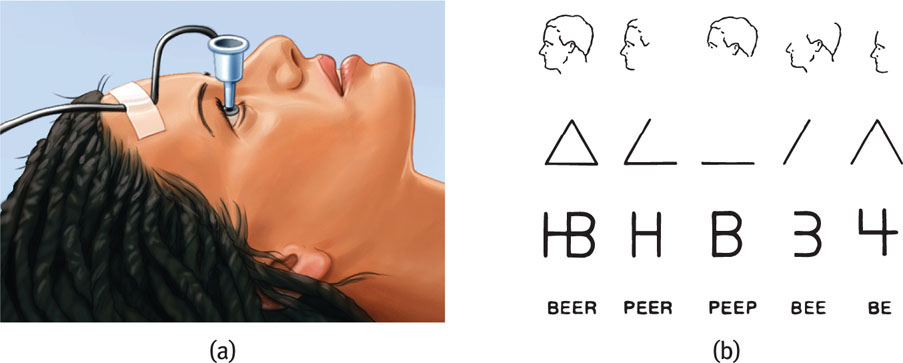
If we project images through this instrument, what will Mary see? At first, she will see the complete image. But within a few seconds, as her sensory system begins to tire, things will get weird. Bit by bit, the image will vanish, only to reappear and then disappear—often in fragments (FIGURE 5.3b).
“My suspicion is that the universe is not only queerer than we suppose, but queerer than we can suppose.”
J.B.S. Haldane, Possible Worlds, 1927
Although sensory adaptation reduces our sensitivity, it offers an important benefit. It frees us to focus on informative changes in our environment without being distracted by background chatter. Stinky or heavily perfumed people don’t notice their odor because, like you and me, they adapt to what’s constant and detect only change. Our sensory receptors are alert to novelty; bore them with repetition and they free our attention for more important things. We will see this principle again and again: We perceive the world not exactly as it is, but as it is useful for us to perceive it.
Our sensitivity to changing stimulation helps explain television’s attention-getting power. Cuts, edits, zooms, pans, and sudden noises demand our attention. Even TV researchers marvel at its attention-grabbing power. One noted that even during interesting conversations, “I cannot for the life of me stop from periodically glancing over to the screen” (Tannenbaum, 2002).
Sensory adaptation even influences our perceptions of emotions. By creating a 50-50 morphed blend of an angry and a scared face, researchers showed that our visual system adapts to a static facial expression by becoming less responsive to that expression (Butler et al., 2008) (FIGURE 5.4).
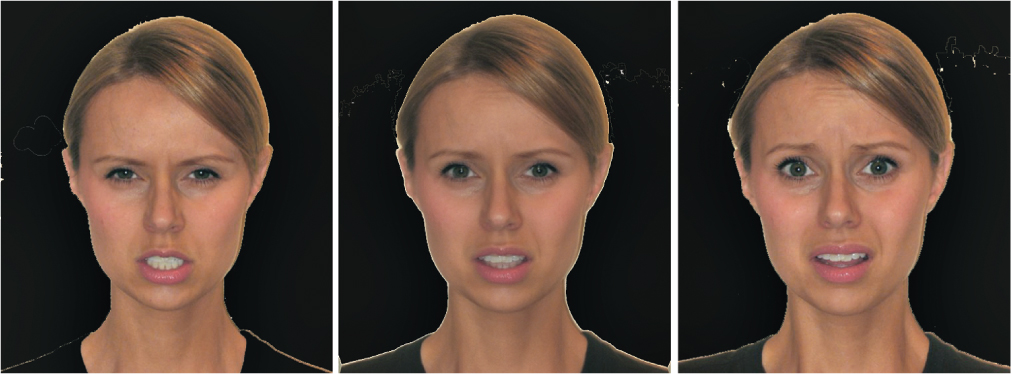
Sensory adaptation and sensory thresholds are important ingredients in our perceptions of the world around us. But much of what we perceive comes not just from what’s “out there” but also from the expectations that live behind our eyes and between our ears. 
138
RETRIEVE + REMEMBER
Question 5.3
Why is it that after wearing shoes for a while, you cease to notice them (until questions like this draw your attention back to them)?
The shoes provide constant stimulation. Sensory adaptation allows us to focus on changing stimuli.
Perceptual Set
5-6 How do our expectations, assumptions, contexts, and even our motivations and emotions affect our perceptions?
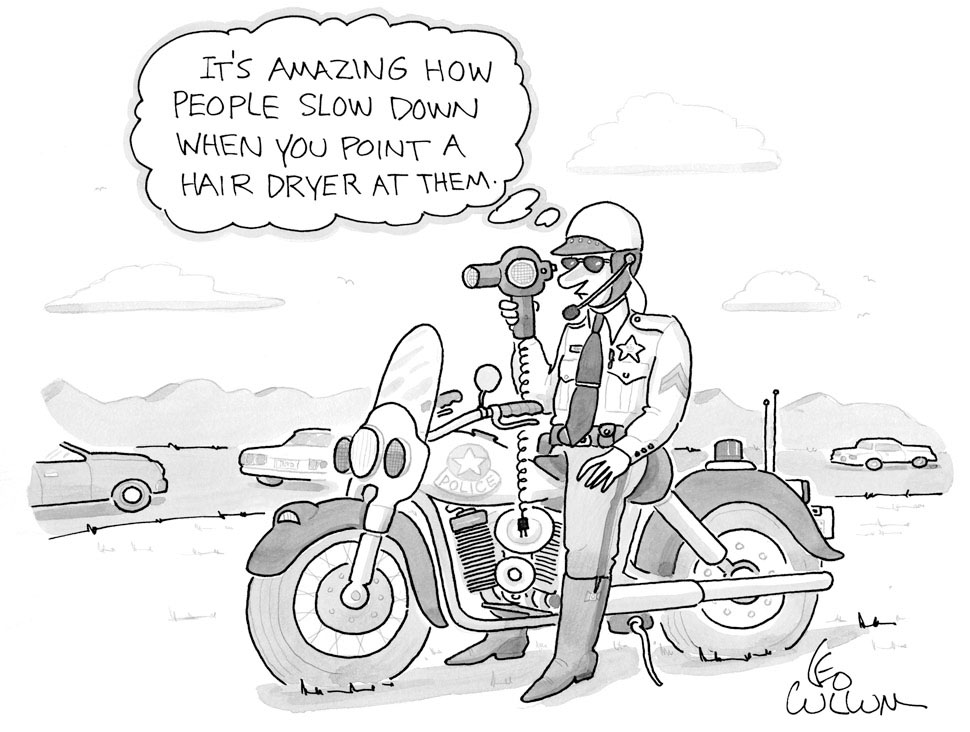
As everyone knows, to see is to believe. As we also know, but less fully appreciate, to believe is to see. Through experience, we come to expect certain results. Those expectations may give us a perceptual set, a set of mental tendencies and assumptions that affects (top-down) what we perceive.
Perceptual set can influence what we hear, taste, feel, and see. In 1972, a British newspaper published “the most amazing pictures ever taken”—of a lake “monster” in Scotland’s Loch Ness. If this information creates in you the same expectations it did in most of the paper’s readers, you, too, will see the monster in a similar photo in FIGURE 5.5. But when a skeptical researcher approached the photos with different expectations, he saw a curved tree limb—as had others the day the photo was shot (Campbell, 1986). With this different perceptual set, you may now notice that the object is floating motionless, with ripples outward in all directions around it—hardly what we would expect of a lively monster.
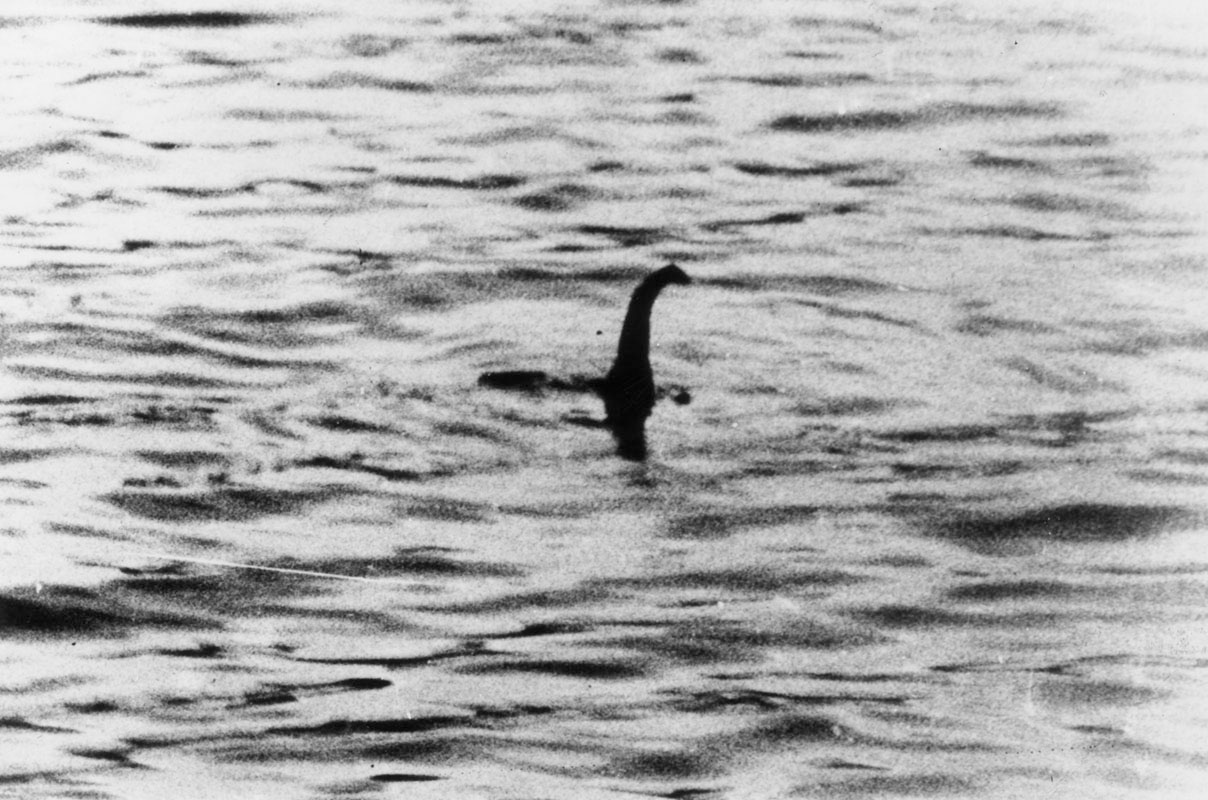
When shown the phrase Mary had a a little lamb many people perceive what they expect and miss the repeated word. Did you?
Perceptual set can also affect what we hear. Consider the kindly airline pilot who, on a takeoff run, looked over at his unhappy co-pilot and said, “Cheer up.” Expecting to hear the usual “Gear up,” the co-pilot promptly raised the wheels—before they left the ground (Reason & Mycielska, 1982).
Perceptual set similarly affects taste. One experiment invited bar patrons to sample free beer (Lee et al., 2006). When researchers added a few drops of vinegar to a brand-name beer, the tasters preferred it—unless they had been told they were drinking vinegar-laced beer. Then they expected, and usually experienced, a worse taste. In another experiment, preschool children, by a 6 to 1 margin, thought french fries tasted better when served in a McDonald’s bag rather than a plain white bag (Robinson et al., 2007).
Context Effects

The effects of perceptual set show how experience helps us construct perception. But the immediate context also plays a role. Some examples:
- What is above the woman’s head in FIGURE 5.6? In one study, most East Africans who were asked this question said that the woman was balancing a metal box or can on her head and that the family was sitting under a tree. Most Westerners, for whom head-carrying is less common and boxlike architecture is more common, said the woman was sitting under a window, indoors with her family. Cultural context helps form our perceptions.
- Does the pursuing dog in FIGURE 5.7 look larger than the pursued one? If so, you experienced a context effect.
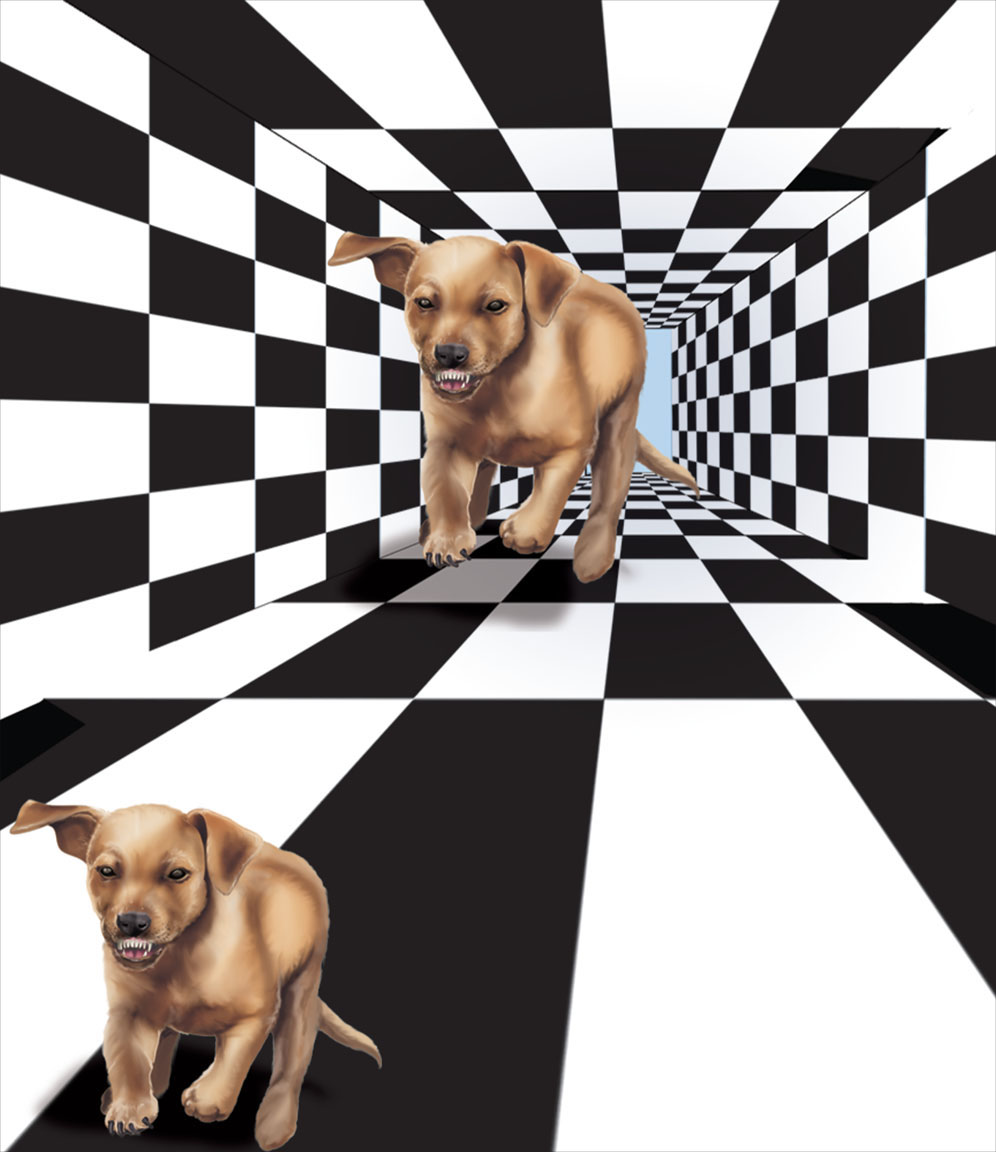 FIGURE 5.7 Context and emotional perception The context makes the pursuing dog look larger than the pursued. It isn’t.
FIGURE 5.7 Context and emotional perception The context makes the pursuing dog look larger than the pursued. It isn’t. - How tall is the shorter player in FIGURE 5.8? Here again, context creates expectations.
 FIGURE 5.8 Big and “little” The “little guy” shown here is actually a 6‘9" former Hope College basketball center who towers over most of us. But he seemed like a short player when matched in a semi-pro game against the world’s tallest basketball player at that time—7‘9" Sun Ming Ming from China.Dennis Geppert/Holland Sentinel
FIGURE 5.8 Big and “little” The “little guy” shown here is actually a 6‘9" former Hope College basketball center who towers over most of us. But he seemed like a short player when matched in a semi-pro game against the world’s tallest basketball player at that time—7‘9" Sun Ming Ming from China.Dennis Geppert/Holland Sentinel
Context can even influence the meaning of spoken words. Hearing sad rather than happy music can tilt the mind toward hearing mourning rather than morning, die rather than dye, pain rather than pane (Halberstadt et al., 1995).
Perceptions are also influenced, top-down, by our motivations and emotions. In experiments, objects people desired, such as a water bottle when they were thirsty, seemed closer than they really were (Balcetis & Dunning, 2010). Angry people more often perceive neutral objects as guns (Baumann & DeSteno, 2010). In each case, motivation creates a bias that energizes people’s perception.
Emotions can similarly shove our social perceptions in one direction or another. Spouses who feel loved and appreciated perceive less threat in stressful marital events—“He’s just having a bad day” (Murray et al., 2003). Professional referees, if told a soccer team has a history of aggressive behavior, will assign more penalty cards when watching recorded play (Jones et al., 2002). Lee Ross has invited us to recall our own perceptions in different contexts: “Ever notice that when you’re driving you hate pedestrians, the way they saunter through the crosswalk, almost daring you to hit them, but when you’re walking you hate drivers?” (Jaffe, 2004).
★ ★ ★
The processes we’ve discussed so far are features shared by all our sensory systems. Let’s turn now to the ways those systems are unique. We’ll start with our most prized and complex sense, vision. 
RETRIEVE + REMEMBER
Question 5.4
In the context of sensation and perception, what does it mean to say that “believing is seeing”?
Because of perceptual set, our experiences, assumptions, and expectations shape our views of reality.
Question 5.5
Does perceptual set involve bottom-up or top-down processing? Why?
It involves top-down processing, drawing on our experiences, assumptions, and expectations.